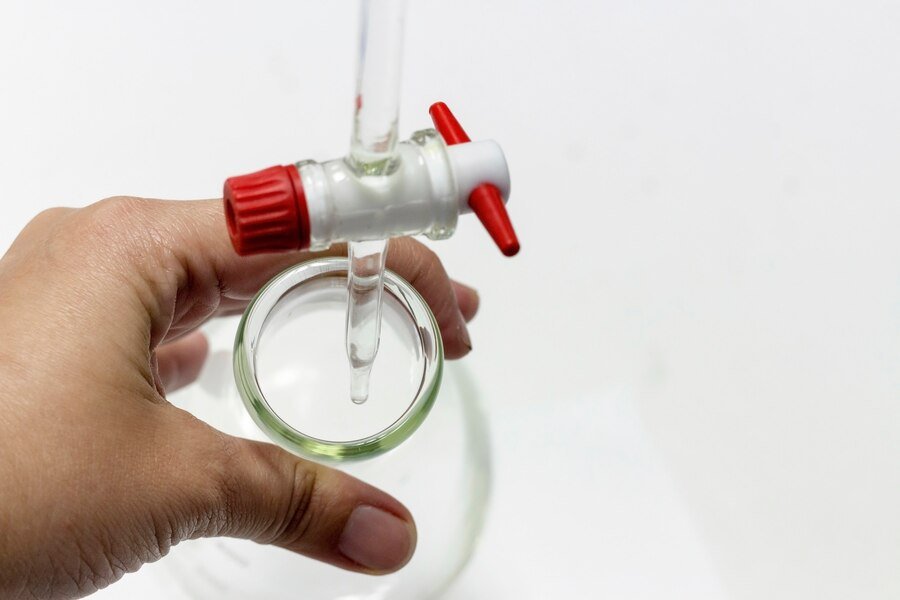Table of Contents
Laboratory equipment is crucial to ensuring the accuracy and reliability of scientific experiments. Among these tools, the burette stands out as a key instrument, like the Erlenmeyer flask in the field of analytical chemistry. This guide explores the workings of a burette, its importance, and why it remains a staple in laboratories worldwide.
What is a burette?

A burette is a graduated glass tube with a tap at one end, used primarily in titration to deliver known volumes of a liquid, especially a reagent. The precision of a burette makes it ideal for experiments requiring accurate measurement and control of liquid volumes.
How does a burette work?
The operation of a burette is straightforward yet meticulous, requiring careful handling and a good understanding of its components:
- Setup and calibration:
- Mount the burette on a stand using a burette clamp.
- Ensure it is clean and free from any previous chemicals.
- Fill the burette with the titrant solution, using a funnel to avoid spills. Remove any air bubbles by opening the tap and letting some solution flow out.
- Reading the Meniscus:
- When filled, ensure the liquid forms a meniscus (the curved surface of the liquid).
- Read the bottom of the meniscus at eye level to avoid parallax error. This reading gives the initial volume.
- Titration Process:
- Place the solution to be titrated in a flask beneath the burette.
- Add a few drops of an appropriate indicator to the flask.
- Slowly open the tap, allowing the titrant to flow into the flask.
- Swirl the flask continuously to mix the titrant and the solution.
- Close the tap when the endpoint is reached, as indicated by a color change in the solution.
- Final Volume Reading:
- Read the final volume of the liquid in the burette.
- Subtract the initial volume from the final volume to determine the amount of titrant used.
Types of Burettes
Burettes come in various types, each designed for specific applications:
- Glass burettes are the most common type, suitable for a wide range of chemical titrations. They offer high precision and clarity.
- Digital Burettes: Equipped with a digital readout for even more precise volume measurements. They are user-friendly and reduce human error.
- Automatic Burettes: Feature a motorized dispensing mechanism for consistent titrant delivery, often used in automated titration systems.
Importance of Burettes in Laboratories
Burettes play a crucial role in various scientific and industrial applications:
- Analytical Chemistry:
- Burettes are indispensable in titration, a fundamental technique in analytical chemistry used to determine the concentration of an unknown solution.
- They enable precise measurement of the volume of titrant added, which is critical for accurate calculations of concentration.
- Quality Control:
- In industries like pharmaceuticals, food and beverages, and environmental science, burettes are used to ensure products meet specific standards and regulations.
- Accurate titration helps in verifying the purity and concentration of raw materials and finished products.
- Educational Laboratories:
- Burettes are essential in teaching laboratories, helping students understand the fundamental concepts of chemistry and develop precise laboratory skills.
- They are used in experiments ranging from simple acid-base titrations to more complex redox reactions.
- Research and Development:
- In R&D laboratories, burettes are used in the synthesis and analysis of new compounds.
- They aid in studying reaction kinetics and mechanisms, providing precise control over reactant volumes.
Best Practices for Using Burettes
To ensure accurate and reliable results, it is important to follow best practices when using a burette:
- Calibration: Regularly calibrate the burette to ensure its accuracy. Use a standard solution to check for any discrepancies.
- Cleaning: Thoroughly clean the burette before and after each use to avoid contamination. Use appropriate cleaning agents and rinse with distilled water.
- Handling: Handle the burette with care to prevent breakage. Secure it properly on the stand to avoid spills.
- Reading the Meniscus: Always read the meniscus at eye level and use a consistent method to avoid errors.
- Temperature Control: Perform titrations at a consistent temperature to avoid variations in liquid volume due to thermal expansion.
Troubleshooting Common Issues
Despite careful handling, issues can arise during the use of a burette. Here are some common problems and solutions:
- Air Bubbles:
- Issue: Air bubbles in the burette can lead to inaccurate volume measurements.
- Solution: Gently tap the burette to release trapped air or run a small amount of titrant through the tap to remove bubbles.
- Leakage:
- Issue: A leaking tap can cause loss of titrant and inaccurate readings.
- Solution: Check the tap for wear and tear. Replace worn-out parts and ensure the tap is properly closed after use.
- Meniscus Reading Errors:
- Issue: Incorrect reading of the meniscus can lead to significant errors in volume measurement.
- Solution: Always read the bottom of the meniscus at eye level and ensure consistent lighting conditions.
- Contamination:
- Issue: Residual chemicals in the burette can contaminate the titrant, affecting the accuracy of the titration.
- Solution: Clean the burette thoroughly between different titrations and use separate burettes for incompatible chemicals.
Innovations and Future Trends
The field of titration and liquid measurement is continually evolving, with new technologies and innovations enhancing the functionality and precision of burettes:
- Digital Burettes: Integration with software and data logging systems allows for automatic recording of titration data, reducing human error and improving reproducibility.
- Advanced Materials: Development of burettes made from advanced materials like borosilicate glass and specialized plastics for increased durability and chemical resistance.
- Automation: The rise of automated titration systems, where burettes are integrated into robotic arms for high-throughput analysis in research and industrial settings.
- Smart Burettes: Future innovations may include smart burettes equipped with sensors and IoT connectivity, enabling real-time monitoring and remote control of titration processes.
Conclusion
Burettes remain an essential tool in laboratories, ensuring precise measurement and control in a variety of scientific applications. By understanding their operation, types, importance, and best practices, laboratory professionals can achieve accurate and reliable results in their experiments. As technology advances, the role of burettes continues to evolve, promising even greater precision and efficiency in the future.
Whether you are a student, researcher, or industry professional, mastering the use of a burette is a fundamental skill that enhances the quality and accuracy of your work, making it an invaluable asset in the pursuit of scientific knowledge and innovation. Learn more

